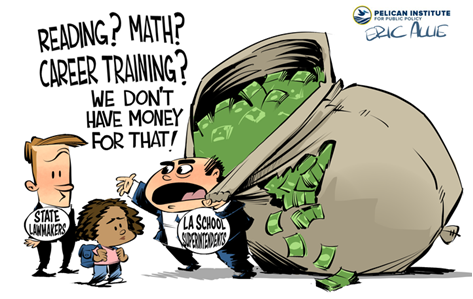
Why Are Louisiana’s Public School Leaders Still Not Spending the Money They’ve Been Allocated to Help Students Learn?

We’ve written about this before—millions of dollars from state coffers allocated to Louisiana high schools to provide students with opportunities like career and technical education (CTE), early college/dual enrollment courses, online and local in-person courses not available at their home school, ACT test prep, internships, and apprenticeships—yet not being used.
Helping students meet graduation requirements and expanding opportunities to get a jump-start on college and career planning have been high priorities for lawmakers over the past decade, after hearing time and time again from colleges and employers that Louisiana’s graduates are arriving to their sites without foundational knowledge in reading and math and skills to succeed in freshman-level college courses or meet employers’ expectations for entry-level jobs. In response, the State Board of Elementary and Secondary Education (BESE) and the Louisiana Department of Education (LDOE) launched several high school programs, initiatives, and supports to help schools respond to this need. They’ve also partnered with lawmakers to allocate significant extra state funding.
But in recent meetings of the state’s Minimum Foundation Education (MFP) Task Force and the Louisiana House of Representatives Appropriations Committee, state officials and lawmakers have questioned why spending these dollars hasn’t been a priority for local school systems.
According to LDOE, school systems are sitting on about $45.5 million in unspent money that was allocated over the past several years to support high school programming. In a state that continues to produce more high school graduates that are not ready for post-secondary education and the workplace than to those who are, this isn’t just a missed opportunity. It’s a disservice to Louisiana’s students and a failure to prepare the next generation to meet the state’s workforce needs.
In most cases, the unspent funds are getting rolled over year after year or “banked” for future use, according to some parish school superintendents. In others, they’re relinquished to other school systems that have spent their entire allocation and are able to spend more.
Nearly $43 million of the unspent money lies in the Career Development Fund, which is a component of the state’s funding formula for public schools, the Minimum Foundation Program (MFP) formula. Guidance issued by the LDOE to school systems last year states:
CDF funds are intended to support increased student access to high-value CTE courses and training. Based on data, BESE and the Legislature concluded that additional funding is necessary to offer CTE courses in high-wage employment sectors (e.g., welding, information technology, manufacturing, etc.). As such, dedicated funds have been included in the MFP, CDF funds, for the exclusive purpose of making high-value CTE courses and training available to more students across Louisiana.
These funds can be used for facilities, materials, equipment, and transportation expenditures related to a high-value training pathway, teacher training, career exploration for students, student internships, and tuition for students to receive instruction or training from a post-secondary institution or training provider.
Nearly $1.6 million has gone unspent in another component of the MFP called the Supplemental Course Academy (SCA), also known as “Course Choice.” These funds support students in accessing courses for high school credit that are not available at their enrolled school. Those courses may include career and technical preparation, courses needed to qualify for TOPS, dual enrollment, and intensive remediation for students struggling to stay on pace for graduation.
Monroe City Schools, for example, returned $112,457 in unspent SCA money, nearly half of its allocation. Livingston Parish School System returned $222,163. The Orleans Parish School System and its large network of independent charter schools returned $498,056, with many individual schools not spending a penny of their allocation.
In addition to state money, school systems continue to return unspent money through the federal Carl D. Perkins program, a long-standing source of CTE funds. While the program does have substantial administrative requirements that should be streamlined, LDOE has provided supports to school personnel to navigate the federal bureaucracy and optimize funding. Some school systems have spent their entire allocations or most of their funds. Others have spent very little and returned large sums of money. And then there are those that don’t even claim the money set aside for them. According to the most recent available report, five school systems (Cameron, Jackson, Red River, Sabine, and Tensas parishes) declined the money altogether.
Soon it will be time for BESE and the Legislature to consider how much money to appropriate to K-12 public education for the next fiscal year. Local superintendents and school boards are sure to make their annual plea for additional state funding to combine with what they receive from local and federal sources. Policymakers would be wise to question them about spending the money they already have, the extent to which students are receiving the supports and opportunities for which it was provided, and how any increase in state funding will be prioritized to meet the needs of Louisiana’s students and the state’s future workforce.




